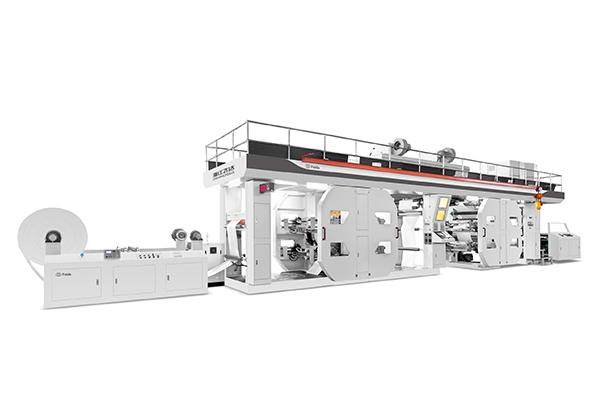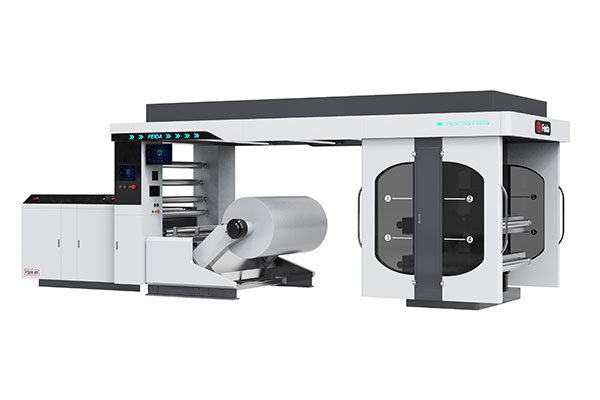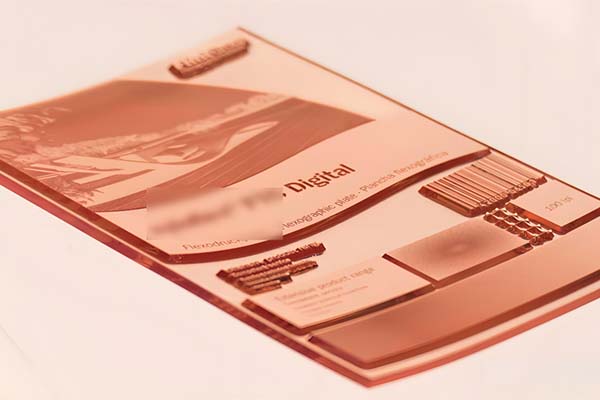Difference Between CI Flexo and Ordinary Flexo Printing Machines
The difference between a CI Flexo Printing Machine (Central Impression Flexo Printing Machine) and an Ordinary Flexo Printing Machine (often referred to as a Stacked Flexo Printing Machine) primarily lies in the design, configuration, and the way the printing process is carried out. Each type of machine is used in different printing scenarios depending on factors like speed, quality, and material handling.
Key Differences Between CI Flexo and Ordinary Flexo Printing Machines
1. Configuration of Printing Units
CI Flexo Printing Machine (Central Impression):
In a CI flexo press, all the printing units are arranged around a single central drum (impression cylinder), which is where the substrate (like paper, film, or foil) is fed through and printed on. The ink from each anilox roller is applied to the substrate via individual printing plates.
This central drum design allows all the printing units to operate in a common alignment, ensuring consistent printing across the entire web.
Ordinary Flexo Printing Machine (Stacked Flexo):
In a stacked flexo press, each printing unit is placed vertically or horizontally, one on top of the other or side by side, with each unit having its own individual impression cylinder.
The substrate is passed through each unit one by one, and each unit applies ink separately. This setup can sometimes lead to misalignment if not carefully calibrated.
2. Printing Quality and Registration
CI Flexo Printing Machine:
CI flexo presses are known for their superior registration (alignment of colors), as all the printing units are aligned on a common cylinder. This eliminates the risk of color misregistration, which can occur when different cylinders are slightly misaligned.
This configuration typically offers better print consistency and quality, especially for high-speed printing runs, where precision is critical.
Ordinary Flexo Printing Machine:
In stacked flexo presses, each printing unit is independent. Although modern systems use advanced registration systems, there is a higher chance of color misalignment between units, especially during high-speed runs or when changing printing plates.
While registration systems have improved, stacked machines generally require more manual adjustments to maintain optimal color accuracy.
3. Substrate Handling
CI Flexo Printing Machine:
The substrate is passed through the machine in a continuous web and wrapped around a central impression drum. This design minimizes tension variations across the web, resulting in smoother handling, especially for flexible materials like films or lightweight substrates.
It is especially beneficial for substrates that are sensitive to tension, such as thinner films or papers.
Ordinary Flexo Printing Machine:
The substrate is passed through each individual printing unit in sequence. While modern stacked machines can handle a wide range of substrates, they might face issues related to web tension, particularly with very thin or very thick materials, since each unit is independently driven.
Tension control is more critical and requires careful management in stacked machines to avoid print defects or web breaks.
4. Speed and Efficiency
-
CI Flexo Printing Machine:
CI flexo presses are generally designed for high-speed operations. The central impression drum design allows the machine to run at faster speeds with more stable web handling, resulting in fewer disruptions and faster job changeovers.
Ideal for longer production runs of labels, flexible packaging, or commercial printing, where efficiency and speed are key factors.
Ordinary Flexo Printing Machine:
While stacked flexo presses can also achieve high speeds, they may not be as efficient as CI flexo presses when it comes to very high-speed runs. The independent operation of each unit can sometimes cause more issues with web tension or misalignment at higher speeds.
Stacked presses are often better suited for shorter to medium-length runs.
5. Cost and Investment
CI Flexo Printing Machine:
Typically, CI flexo machines are more expensive due to their complex design and the precision involved in aligning the printing units. These machines are an investment for high-volume, high-quality printing.
Ordinary Flexo Printing Machine:
Stacked flexo presses are generally less expensive compared to CI flexo presses, making them a popular choice for smaller businesses or for short to medium-run jobs where cost-effectiveness is a priority.
However, because of the potential for misalignment and more manual adjustments, the long-term maintenance costs might be higher.
6. Ideal Applications
CI Flexo Printing Machine:
Best suited for flexible packaging, labels, corrugated boxes, and newspapers that require high-quality, consistent printing across large runs.
Often used in industries where high print quality, consistent color registration, and faster speeds are necessary, such as in packaging, films, and food & beverage industries.
Ordinary Flexo Printing Machine:
Typically used for shorter print runs or applications where high-quality registration is not as critical.
Common in label printing, newspapers, and smaller packaging runs, or in situations where lower capital investment is needed.
Summary Table
| Feature | CI Flexo Printing Machine | Ordinary Flexo Printing Machine |
|---|---|---|
| Configuration | Central impression drum, units aligned around it | Stacked or inline units, independent cylinders |
| Registration Quality | Excellent, minimal misalignment | Can have misalignment, requires more adjustments |
| Substrate Handling | Better tension control, smooth handling | May require more tension management |
| Speed | Higher, optimized for long production runs | Generally good, but less suited for extremely high speeds |
| Cost | Higher initial cost | More affordable for smaller operations |
| Ideal Applications | High-quality, high-volume printing (packaging, flexible materials) | Short to medium runs, labels, and simpler applications |
| Print Quality | Superior, especially for long runs | Good, but can be inconsistent with complex designs |
Conclusion
In essence, CI flexo printing machines are designed for high-speed, high-quality printing with minimal registration issues, making them ideal for large-volume production. They excel in applications where consistent color and precise print quality are critical, such as in flexible packaging. On the other hand, ordinary flexo printing machines (stacked flexo presses) are generally more affordable and suitable for shorter print runs or where cost is a primary consideration, though they may require more manual adjustments to maintain print quality and registration.








